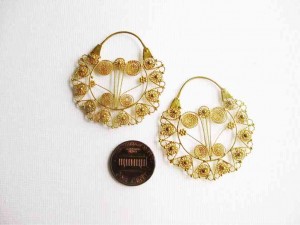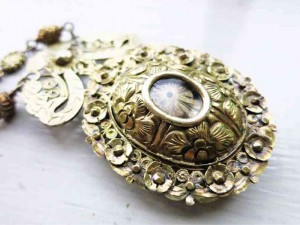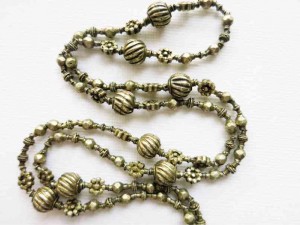
You’ve probably seen them in museums, in antique shops, or in your lola’s baul—they’re tamborins, or traditional long Filipino necklaces that are usually part of a woman’s Filipiniana costume. Patterned after the rosary, tamborins are made out of gold or silver beads, and come with a small, religious reliquary as its pendant.
Once passed down as family heirlooms in Spanish-colonial times, tamborins are now highly collectible pieces that can be bought in antique shops or flea markets. But how can you tell if your find is an antique or not?
Mireille de Guia-Jison, owner of Tambourine Jewelry, an online shop (www.TambourineJewelry.etsy.com) that specializes in tamborins and locally-sourced vintage jewelry from the 1800s to the 1980s, gives us a bit of shopping advice. “When I first started my shop, I had to rely on what the antique dealers told me. They would either say, it’s at least a hundred years old, or the vague answer: ‘Luma na yan,’” recalls Jison.

But over time, and after buying a few pieces that were more recently acquired than vintage, Jison shares these tips.
1) Touch and see if it’s smooth. An overall smoothness and the presence of worn areas in the detailed parts show that the piece has been pre-loved for a long time. “The more seasoned sellers would say that the antique tamborin beads are very smooth when you run your fingers over them. Same goes for the reliquary or relicario pendant.”
2) Compare the size. Tamborin necklaces and vintage Philippine earrings are usually much smaller than our modern-day expectations of how big and grand jewelry should be—in fact, antique creolla earrings should only be as big as a penny. “Safe to say that Filipino women from the olden days were more conservative and kept their bling to a small size,” says Jison.

3) Check the craftsmanship. The saying, “They don’t make them like they used to” is true with vintage jewelry, which has painstakingly fine details that are obviously handcrafted because of their subtle imperfections. “Antique Philippine-made jewelry were very well handcrafted,” says Jison. “Even with good reproductions, some techniques are just too hard to replicate. Or they simply won’t spend months making it.”

4) Inspect the finish. Don’t go for pieces that are garishly gold, or too shiny. “They have this soft gold wash but with some gold darkening on them,” says Jison. “They don’t have this blinged-out look of a 24-karat gold piece unless it’s been recently gold-plated, which some collectors like.”
But even if you exercise a lot of caution when shopping at antique stores or flea markets, more than scoring a priceless collectible, you should still buy a piece that you genuinely like. “I acquire items that I like, so in case it doesn’t sell, then I wouldn’t mind keeping them personally,” says Jison. So, if you stumble upon a piece that you truly love, by all means, keep it.
Check out Tambourine Jewelry’s latest collections online at www.TambourineJewelry.etsy.com, at www. facebook.com/pages/Tambourine-Jewelry and read Mireille’s musings about vintage jewelry on her blog at www.TambourineJewelry.wordpress.com. For more info on the products, e-mail [email protected]














































